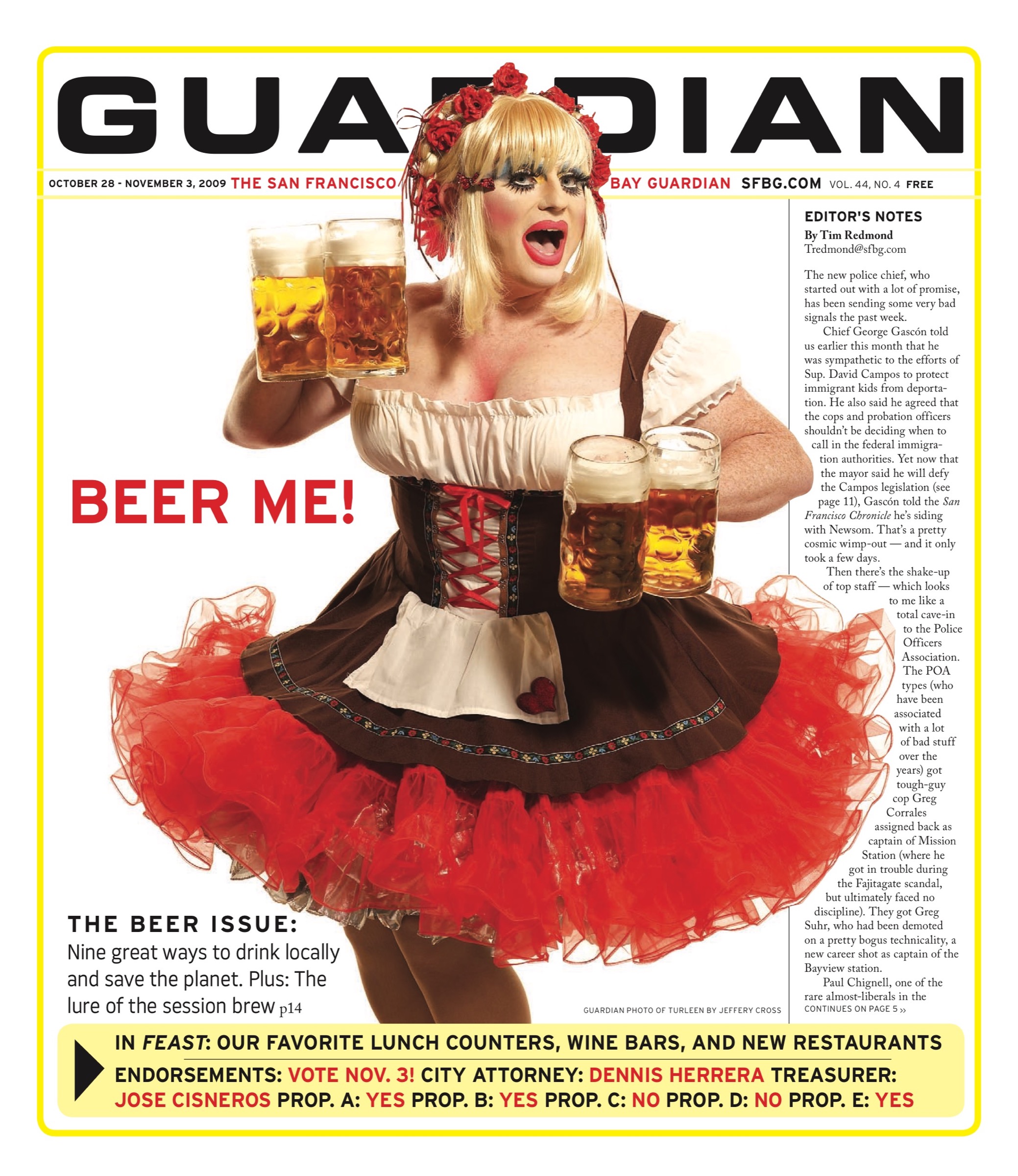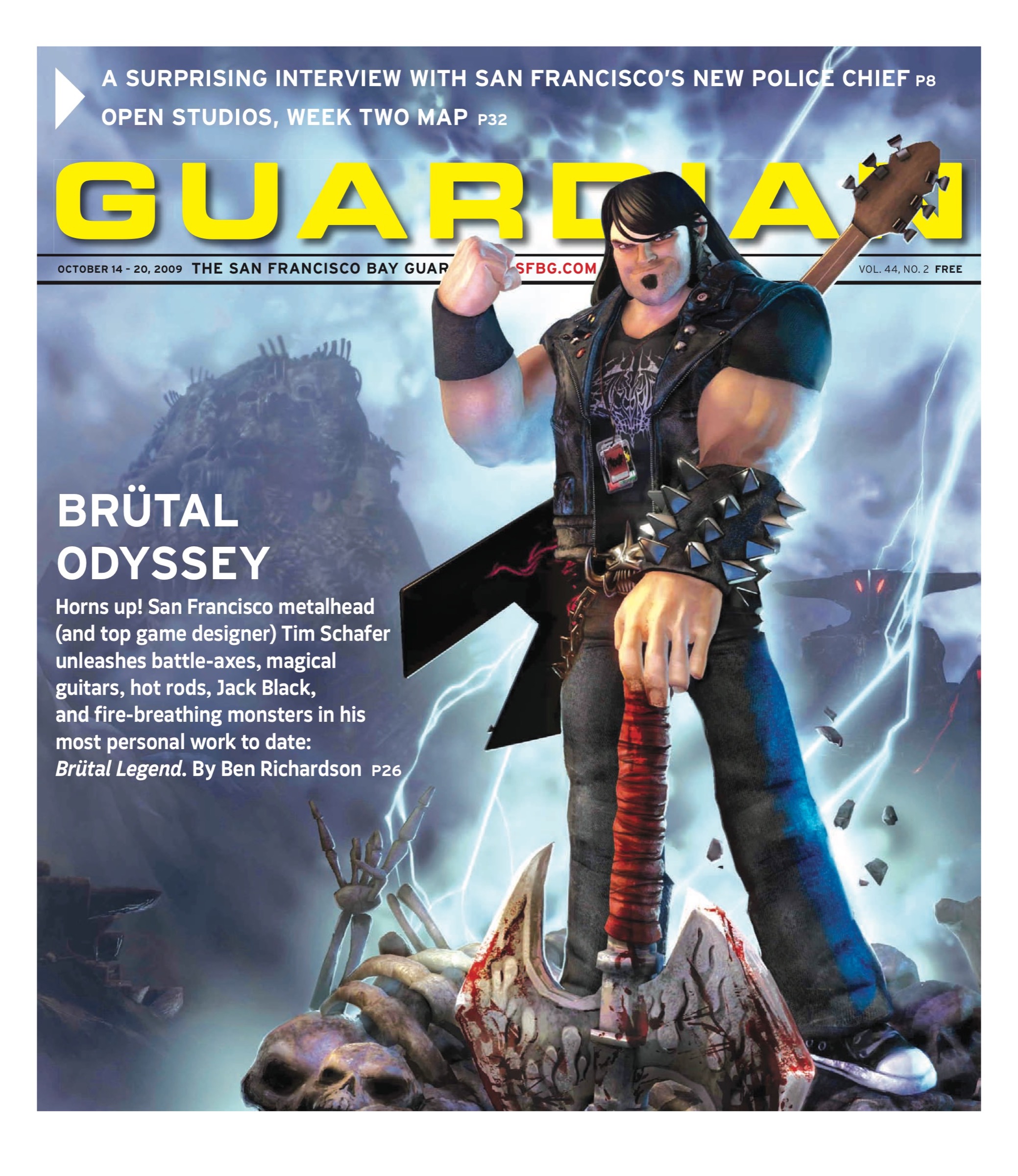culture@sfbg.com
WRITERS We asked Guardian readers to contribute stories or poems that reflected their Bay Area experiences. The catch? Each entry had to be exactly 123 words. So many excellent submissions poured in. Unfortunately, we could only pick 10 winners, which are printed below. The writers will receive a gift certificate to Books, Inc.
ECLIPSED
Her fantasy
revolved around how wonderful it would be to die in an
earthquake that killed her at the exact moment
she was looking up at the shelves in the Macy’s women’s department.
The handbags were being swept into the air and
were floating down towards her. A
set of Moschinos fell like giant colorful raindrops
and her hands were extended towards them, like a desiccated cave-woman about to
experience
the end of a drought. This moment
would be captured as her afterlife when a glass sliver
slipped between her eye and eyelid and gracefully penetrated her brain. She wanted the perfection
of the leather satchels, which she had no hope of ever owning, to eclipse all
the
other moments of her life.
— Hunter Stern
LESSON PLAN
i take the book you made out for coffee, walk along clay until it crests over hyde and i can smile again, weave past grace cathedral, 40s and shorts on the swing set and i fall in love with you at Front Porch drinking drinks with kumquats and rum, flicks of salt disappearing, lips pressed to mason jars, wrappers leftover from japanese candy, 111 minna, some girl’s gold necklace, lamp light reflecting, gray goose and art galleries, thick throated and insecure, while north beach vomits strip clubs and boutiques, scares away hipsters, and at 3am i make a home for you in the space between my breasts, mismatched fabrics hanging over head, cork board alley smiles and
what’s your name again?
— Gabrielle Toft
LABOR DAY 2009
I slip on my pants like a fireman, quick, with practiced determination. I careen my head toward the window. Watch daybreak bang the gray sky back. The closed Bay Bridge arches towards darkness, towards Frisco. I have never seen it without cars lights.
I shuck the sheets off you.
Up, I demand, a drill sergeant.
I snap my bra on, twist it around. I can smell myself, fecund, moist pits. Nervous like a mother. I hate myself.
I ball my shirt up; hurl it at you.
You look up.
What?
I’m going to be a mom, I spit. Taste the implication on my tongue.
You hoist yourself up.
Where you going?
To bike that bridge. What can they do? They can’t stop me
— Tomas Moniz
BEFORE LIGHT CHANGES
Pick a hill. Jump between vantage points. You can spring the entire city, like a kinged checker, or a queen. Morphing like Mad Magazine, folding corners B to A, bending time.
A pharmacy goes BBQ. Sushi boats drift through your unconscious. You got dragged aboard, then woke with a craving. Across, in that park: you’ve tasted heartbreak, and smelled funny dancing, and shot hoops with crumpled resumes, and been winded by a jog.
The city gasps for air just before rush hour, after running all day, breathing hard. Cue the fog. Now it’s dim: the ‘Sco does twister yoga, or the funky gargoyle, gone buck or cupcakin’. A sushi float parades the bay, always revolving, barely perceptible; you’re on board, and circling too.
— Joe Cervelin
TOOTH TALE
Mother wanted me to be the dentist to the stars. I wanted to be the next Hemingway. Mother insisted writers were alkies and wife abusers. I could write prescriptions. Graduated NYU Dental in 1959. Only mention that Al Pacino and John Travolta were patients because I’m a namedropper. For the next 20 years, I inhaled tons of toxic mercury vapors, was bombarded with enough stray radiation and nitrous oxide to turn my toenails and my mien black. After my second wife left me, I fled to San Francisco. Bought a restored Victorian at 164-166 Castro with my cousin, Hal Slate. Hal owned the Cauldron bathhouse and sang in the Gay Men’s Chorus. Hal lived upstairs and I was on the bottom.
— Dr. Stanley Finkelstein
THE SEAWALL
Just a cougar by the seawall. Summer, errr, autumn in the Sunset, she stole a boy from the surf shop. He literally lived in the surf shop.
Gawky girl, watched him get amateur tattoos. Watched him sell pot to Trouble. Bought him pizza. Bought a phone, learned to text.
Kisses and secrets pressed against the seawall. Realize: nothing is lost by getting older.
Ocean Beach is not made of fog, just ghost lovers and culture clashes. Wu Tang Clan and Elliott Smith. Office girls and Rastafarian skate rats. Wearing rings and gangsta players. Foodies and shysters.
She returns home with sand in her highlights and guilt on her sleeve. Then makes love with two men, one by the shore, one as a whore.
— Sadie Craft
NAILS
I always smell coffee when I cross the Bay Bridge.
Mom would point out the Hills Brothers building on the right. "Grandpa
used to work for them."
He kept nails in a red coffee tin. Every summer, my parents would send
me back to the city to live with my grandparents for a bit. He’d get me
to pull nails out of old planks and save the good ones.
Years later, my wife and I came to clear out their house. She rattled a
tin full of rusty nails.
"It’s a real mess. I guess people who lived through the Depression saved
everything."
The old factory is gone, but I still smell coffee on the Embarcadero.
And think of honest work.
— Dominic Dela Cruz
A PAINFUL CASE
Outside of a Shattuck Laundromat a form appeared and paused. I could see just above the pages of my book a squat mass.
— You like Joyce?
There waited a gray-haired wheelchairbound woman, her thin puppetlegs below a square, dense torso.
— Yes.
She spoke about Finnegan’s Wake, about her triptoirelandfathersdeathlovers53disabledlesbianconvertedjewsuicide
life —
conjuring Linnaeus to lift herself from the gelid human sea.
I politely cut her off.
There were three women alongside me folding laundry. A man watching clothes tumble behind a porthole. Two coeds umlike trying to use a machine. The TVfixed attendant stood folding underwear. Eight people in a small room and no one spoke to the other.
I turned my gaze toward the street vainly hoping to tell Shewhospoke
Iamalmostthirtyunemployeduneducatedconfused
my life.
— Carolyn Rae Allen
UNTITLED
Ice cream is my observation food.
I’m sitting on the curb by the Castro Station, watching a nighttime exodus of dapper gay couples and catching snatches of passerby dialogue between bites of an It’s-It.
I listen to them talk about things I know nothing of, though I still strain to hear. Each person walking by, I realize as I munch, is their own story, their own person, and I feel a strange urge to follow them around.
Instead, I look up at the city lights and semi-starry sky, both of which frame a giant flapping flag, whose wind-aided whipping is just audible above the sounds of cars and people.
My snack drips, I wolf it down, and then descend into the station’s glow. — — arim Quesada-Khoury
AN UPLIFT
There are people in this city whom even God does not love. I have spoken to many of them (phoning from the safety of my SOMA office) about diminished social services and life’s decline. The most wretched of San Francisco’s sick, discouraged, and deprived tell me they keep living for one reason alone: their pets. When every last lover’s tolerant embrace has turned cold, dogs and cats do not waiver in their devotion. I only remember to feed myself because Josie needs to be fed, too. She knows I’m sick and ugly, but she loves me nonetheless. Oh Lord, because your charitable light sometimes eludes man through the Bay’s perpetual fog, please lift up this city’s pets and help them do your work.
— Ryan Goldman




